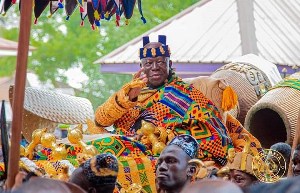- Home - News
- TWI News | TV
- Polls
- Year In Review
- News Archive
- Crime & Punishment
- Politics
- Regional
- Editorial
- Health
- Ghanaians Abroad
- Tabloid
- Africa
- Religion
- Election 2020
- Coronavirus
- News Videos | TV
- Photo Archives
- News Headlines
- Press Release
Opinions of Wednesday, 11 September 2013
Columnist: Antwi-Boasiako, Kwaku
Growth In The Domestic Aviation Industry
: Is It Sustainable?
One of the policy objectives of the Ghana Civil Aviation Authority (GCAA) as provided for in Section 2(e) of the Ghana Civil Aviation Act, 2004 (Act 678) is “to encourage strong and sustainable growth in the aviation industry”. According to the Director General of the GCAA, Air Cdre Kwame Mamphey, “the growth of Ghana’s domestic aviation industry is due to the liberalization policy embarked on by the Ghana Civil Aviation Authority” (BFT, 2/9/2013). This is largely true and obviously in line with Section 2(e) of the Ghana Civil Aviation Act, 2004 (Act 678).
The domestic aviation industry in Ghana has indeed seen tremendous growth over the last 2 years, not just in terms of the number of active airlines operating in the country but more importantly, in terms of passenger uplift. Up until September 2011, there were only 2 domestic airlines, Antrak and CiTylinK, offering scheduled, public domestic services. And as the DG of GCAA stated, the Authority embarked on a liberalization policy that led to the entry into the market of Starbow in September 2011 and Fly540 in the last quarter of the same year. While the existing operators did not dispute the legal authority of the GCAA to open up the industry to competition, they challenged in court the process of licensing Starbow in particular. The case was eventually ‘settled’ out of court. In September 2012, Africa World Airlines also entered the market, a month after CiTylinK had ceased its operations. Thus, currently there are 4 active airlines operating scheduled, public services in the domestic aviation industry, with about 3 more expected to launch their operations in the near future.
Growth in passenger uplift
There is no doubt that the introduction of Starbow and Fly540 created a huge buzz and attracted new air travellers. The initial low fares, seat availability, relatively larger and more comfortable aircraft, coupled with the poor nature of the Accra-Kumasi road in particular (and the generally high safety risk on our roads), all contributed to the explosive growth that ensued. Indeed, total passenger uplift for the last 4 months of 2011 was 53% more than the previous 4 months (from 51,330 passengers for the period May to August 2011, to 78,323 for the period September to December 2011). The unprecedented growth continued in 2012, with passenger uplift growing by 199% over 2011 (544,583 passengers in 2012 as against 181,863 in 2011). The growth has continued in 2013. Between January and July 2013, total passenger uplift grew by 67% over the same period in 2012 (450,674 passengers from Jan-Jul 2013, as against 270,516 passengers from Jan-Jul 2012). In terms of monthly average, passenger uplift in the first 7 months of 2012 was 34,645 while uplift for the same period in 2013 is 64,382. If the 2013 monthly average continues, total passenger uplift for 2013 is estimated to reach 772,584. This would amount to 42% growth over 2012 and 325% over 2011.
Success has a cost
While the initial growth may be attributed to several factors, there is no question the fact that low fares resulting from intense competition has been the driving factor behind the growth in the domestic aviation industry. From Starbow’s introductory one-way fares of GHS99 to Kumasi and GHS149 to Tamale, we have seen airlines offering one-way fares of GHS45 to Kumasi and GHS100 to Tamale. For anybody who has worked out cost of operating the various aircraft being operated by the domestic airlines (i.e., Starbow’s BAe 146-300, Antrak/Fly540’s ATR 72-500 and Africa World Airline’s E145), these promotional/competitive fares are nowhere near break-even for any of the aircraft mentioned above. Over the months, it has become clear that while passengers are enjoying the low fares, the airlines are bleeding and losing money. Shareholders have had to pump in more cash to shore up losses and effectively subsidize the low fares that customers are enjoying. How long will shareholders of domestic airlines continue to subsidize the growth in the domestic aviation industry? How long are domestic airlines prepared to make losses, even as they continue to offer low fares in order to attract more passengers?
Some key challenges facing the domestic aviation industry
There is no doubt one of the key objectives of GCAA’s liberalization policy is to increase competition, bring down fares and thereby grow the domestic industry by encouraging more people to travel by air. All things being equal, the industry will grow by leaps and bounds if airfares continue to fall. The GCAA (and its Economic Regulations department) would however have to work out how to sustain the achievement of that objective in the face of losses being incurred by the existing airlines (and most likely the new entrants). The issue of losses resulting from low fares which are the by-product of intensely high competition, can be traced to what the airlines describe as ‘over capacity’. This is simply having more airline seats available for fewer travellers. In other words, the number of passengers available in the market is not enough to fill all the aircraft deployed by the airlines. If there is over-capacity with 4 airlines, then the industry must brace itself for when the number increases to 7!
In the UK, in 2012, the total number of domestic passengers uplifted was 19,057,985. The number of domestic airlines was 13. The airlines were: Aurigny, BA Cityflyer, Blue Island, BMI Croup, BMI Regional, British Airways, British International Helicopter, Eastern Airways, EasyJet, FlyBe, Skybus, Jet2 and Loganair. While EasyJet (31%), FlyBe (26.4%) and British Airways (25.6%) dominated the market, on average there were about 1,465,999 lifted by each domestic airline in the UK in 2012. In the same year, and in spite of the unprecedented growth in the domestic aviation industry in Ghana as previously mentioned, there were a total of 544,583 passengers uplifted by 4 airlines. That averaged 136,145 passengers per airline for the entire year. Even going by 2013 estimates of 772,584 passengers, each airline will uplift 193,146 on average, although Antrak and Starbow together will uplift over 75% of passengers between them. It is significant to note that the average passenger uplift for one domestic airline in the UK in 2012 was almost 2.7 times the total passenger uplift for the entire domestic industry in Ghana in the same year and almost 1.9 times our 2013 estimated passenger uplift for the entire industry. The congestion that passengers witness at the domestic departure lounge is not necessarily evidence of high load factors throughout the week. Rather, the inadequate facilities at the airport are not able to cope with all 4 airlines departing around the same time in the morning and evening. Apart from Fridays, Saturdays and Sundays the airlines have to significantly lower their fares in order to be able to achieve decent load factors. The market is just not big enough for the current 4 operators, not to talk about 7 airlines. The size of any aviation market is a direct function of the size of the economy and the size of the middle class. As Ghana’s economy grows and the size of the middle/working class grows, the number of people who can afford to travel by air will increase. Until then, the current situation where all operators are losing money is unsustainable.
The Government of Ghana has shown the way with the current policy on the telecom sector, where “government has decided not to license new telecom operators to safeguard the integrity of the industry”. A senior official of the National Communications Authority is also quoted as saying that "Ghana's spectrum for additional operators has been exhausted by the six existing licensed operators, and therefore there is no room for new ones." The GCAA must also now determine how many airlines can profitably operate within the domestic aviation industry at any point in time, given the size of the domestic market at that time. There cannot be liberalization ad infinitum.
If you pay peanuts, you get monkeys
While the GCAA should be commended for its strict enforcement of safety regulations, there are challenges when it comes to the quality of service that domestic airlines provide. There is no excuse whatsoever for poor customer service. But when it comes to the type of equipment/aircraft deployed, there is a direct relationship between projected market size/revenue and the level of investment that any airline may be able to make in the domestic aviation industry. Investors invest with the view to making some return on their investment at some point in time. Nobody will invest substantial amount of money in an industry where all operators are losing money. Will you invest US$83.6 million in a new A319 and deploy it in a market of 773,000 passengers per annum and charge GHS100 (US$47.62) one-way for a flight of 1 hour? How about acquiring a 20/30-year old stored aircraft for some US$1.5 million, spend another US$1.5 million to ‘sex’ it up? While the GCAA may want airlines to charge US$50 for a flight of 1 hour in order to grow the industry, it should be clear that there is a limit to how much investors are willing to spend for this kind of market.
Elsewhere in the world, when travellers choose budget airlines, they know they cannot expect all the service they enjoy on ‘traditional’ carriers. Even then, airlines charge decent and realistic fares that make them profitable. London to Manchester is just about 1 hour flight time, the same as Accra to Tamale. So why should Virgin charge between $102-$137 one-way for economy from London to Manchester and British Airways charge between $224-$248 for the same route, but a Ghanaian airline should charge $50 one-way from Accra to Tamale? If you were an investor with US$83.6 million to acquire an A319, would you deploy it in a market of 773,000 passengers charging $50 for 1-hour flight or in a market of 19 million passengers charging at least twice as much?
Price of Aviation Fuel
One of the reasons cited by Virgin Atlantic for pulling out of the Accra-London route is the high price of aviation fuel in Ghana. While some people have rubbished Virgin’s claim, there is no doubt that most airlines operating in Ghana do complain about the price of aviation fuel. Domestic airlines are no exception. In a recent meeting with the Board of Airline Representatives in Ghana (BARG), the Director General of GCAA was quoted by the Business and Financial Times (BFT) as having “asked the airlines to reciprocate government’s 20% reduction in aviation fuel by reducing their fares for passengers to enjoy the benefit”. The Hon. Minister of Transport has also been reported to have made a similar request in recent past.
I am not too sure about the percentages, but I do know that from a high of $1.30/litre, the price of aviation fuel was down to $1.0875 in July 2013 but rose again to $1.22 from September 1, 2013. While on its own it may sound a reasonable reduction in the price of aviation fuel, the public must understand that airlines operating in Ghana still consider the current price too high compared to prices in other markets. For instance, the current price of $1.22/litre or $4.65/gallon in Ghana is much higher than $3.32/gallon at London Gatwick, $3.13/gallon at London Heathrow and $3.13/gallon at Manchester Airport. You can check out the prices of aviation fuel at many airports across the world by visiting: http://aeroportos.weebly.com/fuel-prices.html#.UimeV8sgGSM.
The simple implication, for purposes of comparison, is that if you operate an aircraft from Heathrow to Manchester, a journey of 1 hour, not only will you be able to charge a higher fare than an airline operating the same flight time from Accra to Tamale, but you will also pay less for aviation fuel. You therefore have a better chance of making profit in the UK domestic aviation market than in Ghana’s, simply by looking at cost of aviation fuel and level of airfares.
Domestic airport infrastructure and aircraft utilization
Domestic airport infrastructure is still very basic and not adequate to cater for the current growth in the aviation industry. Passenger handling facilities like waiting areas and scanners are inadequate or in some cases non-existent (Sunyani, for example, doesn’t have a scanner and passengers have to endure unpleasant body and baggage searches everyday!). Apart from Accra and Takoradi, the other runways all need rehabilitation. The short runway in Sunyani limits the number of passengers and baggage that an aircraft can lift out of Sunyani. The Kumasi runway is currently undergoing rehabilitation and Tamale is expected to be upgraded into an international airport. But the biggest challenge is the absence of runway lights to allow for night operations that could increase aircraft utilization and reduce cost. Whether you own or lease the aircraft, you require a certain minimum utilization to justify the investment. Being restricted to 6 a.m. to 6 p.m. operations is highly inefficient and expensive. And while management of airports is the responsibility of the Ghana Airports Company Limited (GACL), the GCAA must equally be concerned about efficiency in the industry. Under Section 2(c) of Ghana Civil Aviation Act, 2004 (Act 678), one of the objectives of the GCAA is “to facilitate efficient aviation operations”. Having more than 4 domestic airlines operating in a market of 773,000 passengers, charging $50 for 1-hour flight and operating from 6 a.m. to 6 p.m. can hardly be described as efficient.
-------------------------------------- Kwaku Antwi-Boasiako
Chief Commercial Officer
Antrak Air Ghana Limited
Cell: +233 246 282 030 Email: kwaku@antrakair.com Web: www.antrakair.com Twitter: @AntrakAir FaceBook: Antrakair --------------------------------------










